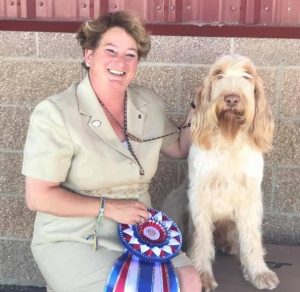175 — Tibetan Mastiff History, Lore and Modern Living

Tibetan Mastiff History, Lore and Modern Living
“No one knows where they came from,” said Sabrina Novarra, one of the original Tibetan Mastiff breeders in the U.S. “The myth of the old monks of Tibet say that snow leopards bred with wolves. Now, we know that’s not true. But, we cannot trace the ancestry. They are the oldest large breed in existence.”
Novarra acquired her first Tibetan Mastiff in 1987 and worked to help establish the breed with the American Kennel Club, where it was recognized in 2007.
Low key breed is long-lived but not easy to train
She said this ancient breed is relatively healthy and long-lived, but, while generally low key, they are not particularly biddable.
“This is a landrace breed,” Novarra said. “… basically, a breed that has evolved itself as opposed to us evolving it. They are self-thinkers. They are not easily trained. You learn after you’ve had them as long as I have, that you make them think it’s their idea to be trained.”
In Tibet the dogs developed as family and flock guardians who were tied during the day and roamed the village at night as protection. They still bark at night if they are outdoors, as that was their job in ancient times.
“This is not a dog if you want to do agility and obedience and take 300-mile hikes, this is not the dog for you … they’re very lazy,” Novarra said. She did note that she accomplished an obedience title on one of her older girls.
The dogs are very large and powerful and need significant amounts of socializing, according to breeders.
“Tibetan mastiffs need to see everything twice,” said Dan Nechemias, owner of the 2018 National Specialty Best of Breed winner. “Just because they saw a red basketball doesn’t mean that they’ll accept a yellow basketball. They were bred for 2000 years to be suspicious of absolutely everything but their family. So, everything that they see in their space — which is their entire visual field — is a threat until they decide it’s otherwise.”
Nechemias, who purchased his first Tibetan Mastiff in 2001, adds that, like many of the working and guardian breeds, the Tibetan Mastiff is very discerning about people they meet.
“… Tibetan Mastiffs are wary of people that are determined to meet them,” Nechemias said. “So what happens is the person’s just really working hard. They’re staring at the dog — you should never stare down an Asian breed much less a Tibetan Mastiff — they’re in their face. … If you ask a Tibetan Mastiff permission to touch it, it will wonder why you’re asking it permission. They’re an incredibly sensitive breed and then they say well this person’s asking me permission they must not be OK.”
KNOWLEDGE IS POWER — FRANCIS BACON
When you become a patron of Pure Dog Talk you’ll tap into an exclusive community of experts to help you and your dog be blue-ribbon best at whatever you do with your purebred dog! Your support helps keep the MP3's rolling at Pure Dog Talk!
As a supporter, you’ll immediately gain access to the weekly Pure Pep Talk SMS, Pure Pep Talk private Facebook group, and priority emails. Patrons can choose to level up to the After Dark Zoom and a Patrons Digital Badge for their website— even a private counseling session with Laura on any topic.

DON'T MISS AN EPISODE!!













I’ve never heard about dog’s being healthier when left in tact. I’ve always heard that its better to spay/neuter because of cancers, pyometra, etc. Did you do a podcast on this topic? I’m very intrigued.
Yep, a couple on the topic. Do a key word search here for Marty Greer’s first interview — on Breast Cancer Awareness in dogs… we cover it there.